
Why its Important to Refer to the Appropriate Service Manual
Every vehicle will eventually malfunction and require corrective action or repair. The required work can be performed by the owner or a professional service technician. Unfortunately, due to the age of our vehicles, it is difficult to find a technician with the applicable experience. Sure, they will understand how a carburetor works, but most likely, have never serviced or rebuilt a Carter YF.
The alternative to hiring a service technician is to troubleshoot the problem and make repairs yourself. Even if you know how to make the repair, it is good shop practice to refer to the service manual. If you do not know what to do, the service manual provides detailed, step-by-step, instructions.
Figures 1 and 2 show the Service Manual and Master Parts List applicable to a 1960 Willys Utility Wagon. The same manuals are available for other years and models, such as an FC-150, CJ5, etc. These two manuals can be downloaded by clicking on the links below, or purchased on-line from various sellers. The price will depend on the condition and whether it is an original or a reproductions.
Most questions regarding how something works, and about how to fix or adjust it, can be answered by studying the service manual. Exploded views of components and systems, along with part numbers, are found in the master parts list. These two references are what I used to manage the appearance goals.

Benefits of Using a Service Manual
Using a service manual ensures you follow the correct procedure and are aware of operating characteristics and specifications.
- Save time – It is not unusual to pay someone to fix something then realize that it was not difficult, and with some guidance, you could have done it yourself. Rather than scheduling an appointment, you can do the work at your convenience.
- Save money – It is my experience that labor costs are usually one-half to one-third of a typical repair charge.
- Learn a new skill – Adding to your skill set is always good. What you learn can be used on other projects and to help others.
- Acquire new tools – From my perspective, you can never have too many tools.
- Do not be taken advantage of – To me, this may be the biggest benefit, especially when owning and operating a decades old vehicle. There are people who are convincing when talking about their knowledge and skills but then fall short when doing the work. Even if you have no interest in doing the work, it is a good idea to be able to get a sense of how well the person you are about to hire understands what needs to be done, how to do it and how long it should take. I like to say trust but verify.
- Make rational decisions – Even if you want to do the repair, sometimes it is necessary to ask for professional help. Referring to a service manual helps to understand which tasks associated with a repair are within your skill set. Sometimes, the saying “you know enough to be dangerous” is the truth.
- Independence – there may be an occasion in which you experience a vehicle breakdown in a remote area. Being stranded for hours, or perhaps days, due to something simple is frustrating.
- Prevent damage to parts – Many times, how something works or comes apart is intuitive, but sometimes that is not the case. In those cases, it is easy to damage a perfectly good part.
- Prevent personal injury – Getting injured when working on a vehicle is always a possibility. Reading the service manual before doing work provides familiarization with the component, etc. and minimizes an unexpected outcome.
- A sense of accomplishment – Solving problems, building things and helping other always feels good. I recommend reading “Zen and the Art of Motorcycle Maintenance: An Inquiry into Values” by Robert M. Pirsig, 1974.
How to Handle Modifications
If the vehicle is modified, as mine, the changes will not be covered in the service manual or master parts list. In my case, modifications are documented in the Build Details, Drawings and Wiring sections. OEM service manuals for equipment installed as part of those modifications, such as the superchargers, are also included in this section.
Auxiliary Equipment & Options
The service manual does cover some auxiliary equipment in Section U – Miscellaneous, but it is not all-inclusive. For example, a service manual from Koenig or Ramsey is necessary to service and repair their winches and power take-offs. Although few options were available, there are OEM installation instructions available for the spotlight, AM radio, panel heater, etc. Almost everything has some type of user guide and/or service manual – sometimes it is a challenge to find.
SERVICE & OPERATING MANUALS
CLICK ON A TITLE TO VIEW THE DOCUMENT
